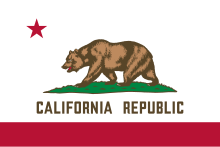Monarch (bear)
Monarch (* before 1889 ; † May 1911 in San Francisco , California ) was the last grizzly bear ( Ursus arctos horribilis ) captured in California . It was the model for the flag of California .
In captivity he lived first in Woodward's Gardens , later in Golden Gate Park . His stuffed body is now in the California Academy of Sciences .
prehistory
William Randolph Hearst , the editor of the San Francisco Examiner , commissioned reporter Allen Kelly (also spelled Kelley ) to find a grizzly bear in the nature of California. The order was preceded by a dispute in which Hearst made it clear that he was assuming the grizzly bear extinct in California. Kelly was not only supposed to bring photo evidence from his research, but to capture a bear alive.
Several months sought Kelly with an expedition team in the San Gabriel Mountains in Ventura County for a live specimen. At the end of October 1889 they found a large male on Mount Gleason who they lured into a live trap filled with honey and mutton .
Kelly described the grizzly bear as follows:
"He stands four feet high at the shoulder, measures three feet across the chest, 12 inches between the ears, and 18 inches from ear to nose, and his weight is estimated by the best judges at from 1,200 to 1,600 pounds."
"He stands four feet tall at the shoulder, measures three feet above his chest, 12 inches between the ears, and 18 inches from ear to nose, and his weight is estimated by the best of judges to be 1,200 to 1,600 pounds."
Kelly gave the grizzly the name "Monarch". The bear was transported to San Francisco by sledge, cart, and train through eastern Ventura County. Monarch, the last grizzly bear captured in California, was greeted with a parade and fanfare on November 3, 1889.
Life in captivity
Monarch was housed in Woodward's Gardens Bear Grotto after Golden Gate Park rejected keeping the bear. Monarch was shown to the public for the first time on November 10, 1889, and 20,000 visitors came to see the animal.
After Woodward's Gardens closed, Monarch was held in Golden Gate Park. He exhibited depressive behavior and also managed to break out of his enclosure, but was recaptured. In 1903 he was socialized with a female specially brought from Idaho. With this he fathered two young animals that were born in December 1904. He survived the 1906 San Francisco earthquake in Golden Gate Park .
In May 1911, Monarch was euthanized after reaching a very old age and suffering from arthritis . It was stuffed and then exhibited first in the MH de Young Memorial Museum and later in the California Academy of Sciences . Over the years, the almost black fur faded to a reddish-brown hue. The skeleton is kept in the University of California Museum of Paleontology .
Symbolic figure
After the great San Francisco earthquake in 1906, the monarch became the symbol of strength and renewal. So posters were created with a picture of him, which should give courage to the population.
Monarch is considered to be Herbert Fleishhacker's inspiration for the planning and opening of the San Francisco Zoo .
The grizzly bear has long been the state animal of California. As such, it was depicted in early drafts of the California flag . In the last revision of the state flag, Monarch was drawn as the motif of the California flag. Monarch's stuffed preparation is also presented as a flag motif in the California Academy of Sciences. In the foreground, the red stripe and the words California Republic are attached to the showcase, the bear's body is posed on four legs on a green floor and in the background there is a red star above the head to the left.
Individual evidence
- ↑ a b c d e f g The Monarch Bear. In: www.monarchbear.org. Monarch Bear Institute, accessed October 13, 2020 .
- ↑ a b c d e f g h i j Late 1800s: The Bear Beginnings. In: www.sfzoo.org. Retrieved October 13, 2020 .
- ^ The Monarch Bear's Mate and Cubs. In: www.monarchbear.org. Monarch Bear Institute, accessed October 13, 2020 .
- ^ History and Ritual Honoring of the Monarch Bear. In: www.monarchbear.org. Monarch Bear Institute, accessed October 13, 2020 .
Coordinates: 37 ° 46 '12.4 " N , 122 ° 27' 59.1" W.


